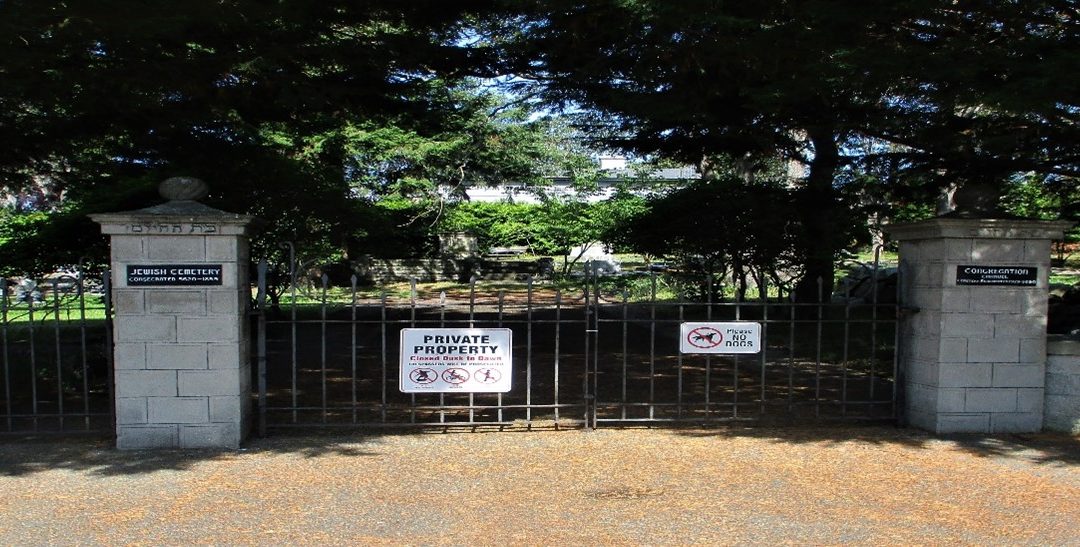Guest post by Ryana
Our final class in ANTH 367 provides a chance to reflect on teamwork, lessons learned from the Jewish community, and giving thanks.
Our last day
To me, it feels like just yesterday that we had all gathered at UVic to meet for the first time. Yet, yesterday marked our final class together.
With the hot sun blaring down on us, we spent our last day completing various tasks that we had learned over the past few weeks. Some of us took photos of monuments while others cleaned gravestones. Other students completed monument record forms while others were taught by Thea Sawin how to use LiDAR.
And so, with our final class over, I wanted to take a few moments to reflect on my time in this class.
Becoming a team
When we first started this class, most of us had no idea what elements to include in monument photos or the correct motion to use when cleaning a grave.
Yet, with each day passing day, I saw how each of us grew in confidence and our abilities. For instance, I can remember when a classmate of mine learned how to take photos of graves in the morning and then by the afternoon, they taught me how to do it.
From every lunch we ate together outside the cemetery’s gates to every late bus we waited for; I felt that we truly became a team. Whether you needed help taking a photo of a grave or figuring out what motif was on the top of a monument, someone was always there to help.
Essentially, as a group, we sweated, learned, laughed, and grew together as students and people.
Victoria’s Jewish community
In addition to becoming part of a team, I also really enjoyed every opportunity we had to learn about the Jewish community.
When we visited Rabbi Harry, we learned that a central idea in Judaism is that you don’t do good deeds in life so that you will be rewarded in death. Rather, you do good deeds and live a good life for the sake of doing good deeds and living a good life.
Working in Victoria’s Jewish cemetery, I know this idea remains at the core of Victoria’s Jewish community as every grave is carefully looked after, respected, and memorialized.
For example, one of the core components of this class was working with Brian Whiting and learning about GPR. Because some of the oldest markers were lost or damaged in the past, there are some unmarked graves. GPR was then used to respectfully make sure that members of the Jewish community will not be disturbed in death.
We also learned about how the Jewish community memorializes one another. For instance, Carl Hughes explained how difficult it is to carve granite or detail markers without today’s technology. From this, I realized just how much care members of the Jewish community (both past and present) put into remembering community members’ lives.
This level of care continues today, which we saw in our cemetery visit with Richard Kool and Amber Woods. Whether an individual had died one hundred years ago or ten, Richard and Amber knew personal stories about every person in the cemetery. And in every detailed account, I remember feeling the life the Jewish community breathes into death.
Communities past and present
I found that working in a cemetery humanizes the graves you are working with. As I found that you begin to see beyond the granite markers and learn about the people they commemorate.
With every moment spent working in the cemetery, I felt the weight of the work I was doing. When you take the painstaking time to record every curve of a Hebrew inscription, you realize the importance of each letter. As you aren’t just writing out a Hebrew letter you are tracing the words that capture a life.
Listening to local historians tell stories about individuals buried in the cemetery, you realize that cemeteries are more than a place of burial. But rather, they are a place where history lives on.

A Hebrew inscription on one of the monuments at Victoria’s Jewish cemetery. Image taken by: Cooper B.
Giving thanks
I believe that with all these experiences, thanks are needed. And so, I am thankful to have had this opportunity of learning in a hands-on environment. I am thankful to my classmates who taught me the definition of teamwork. It has been an honor to learn, grow, and work together.
I am also grateful to the Jewish community for inviting us into their sacred spaces and showing me the life that exists in death.
Before this class, I thought cemeteries were simply full of graves and death. But now, in working in this class and with the Jewish community, I understand that Victoria’s Jewish cemetery is full of community and life.
References
GSSI. (n.d.). What is GPR? https://www.geophysical.com/whatisgpr
National ocean service. (2023, January 20). What is lidar? https://oceanservice.noaa.gov/facts/lidar.html#:~:text=Lidar%20%E2%80%94%20Light%20Detection%20and%20Ranging,Lighthouse%2C%20Dry%20Tortugas%2C%20Florida.
The Jewish cemetery of Victoria, British Columbia. (n.d.). https://jewishcemeteryofvictoriabc.ca/

